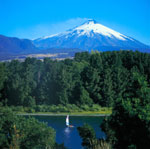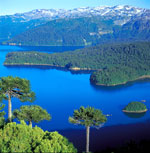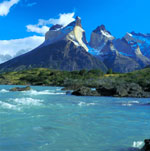The Far
South (Patagonia)
 |
Patagonia
is the setting for some of the
world's greatest adventures. Even
if we don't know much about the
area, its name dwells in our subconscious,
whispering in our ear untold stories
about this far corner of the world.
We imagine vast stretches of
silent wilderness, tempestuous
seas, and wind-blown loneliness.
The first Europeans to lay eyes
on this land were led by Ferdinand
Magellan, the first explorer to
cross the perilous Straits that
bear his name today. His expedition
named the continent Land of the
Patagons, or Big Feet, because
of the large footprints they found
in the snow, giving rise to the
myth of a race of giant Patagonians. |
They saw the smoke of native fires
darkening the southern horizon, so they
named this region Tierra del Fuego,
or the Land of Fire. Thus began the
legend of Patagonia.
The indigenous groups that lived in
Tierra del Fuego fully deserved to become
legendary, being the world's first and
greatest adventurers.
Their
arrival in Tierra del Fuego was
the final stop on the longest
human migration ever. They had
arrived at the end of the world,
where the Andes sink into the
sea and glaciers creep towards
the shore.
With nowhere else to go, they
stayed, fishing from their canoes
along the coastline, gathering
shellfish, and hunting guanacos
and rheas (South American ostriches)
on the pampas. Photographs from
early in the century show a Stone
Age culture where extremes had
crystallized: It was the end of
the road for history's longest
wandering people.
|
 |
 |
Protected
from the rain on the east side
of the Andes, the Patagonian pampas
are an enormous desert; some say
it's one of the world's five largest.
On the west side of the Andes
lies a different world. Here,
both the Central Valley and the
Coastal Range have dropped into
the ocean. What were once glacial
valleys are now fjords, and what
were mountain peaks are now islands.
Erosion along the coast has exposed
the sources of hot springs, while
the huge glaciers continue to
break up the landscape, making
sea or air travel through the
region a necessity.
|
Large forests stretch over the Andes
Mountains from the Pacific coast to
the edge of the continent, crossed by
winding emerald-green rivers that carry
glacial sediment to the sea, creating
a habitat for reckless trout and salmon.
This vast territory is really two separate
regions divided by the Southern Ice Fields.
Northern Patagonia is one of
the last great wilderness areas
in the world. It is reached
by a gravel road known as the
Carretera Austral, the Austral,
or Southern, Highway, completed
in 1988. However, overland access
to the road is not yet complete,
and travelers on this Southern
Highway must board several ferries
to cross the mouths of the great
fjords.
Here, the port of Chaitén
provides access to the north
end of the Austral Highway,
where the rafting and fly fishing
are among the best in the world,
and visitors can take cruises
to see the glaciers and island
hot springs. Farther south lies
the city of Coyhaique, the capital
of the Aisén Region,
an ideal spot for fly fishing
and for organizing overland
trips to the southern part of
the Austral Highway, to General
Carrera Lake, and the Ice Fields.
|
 |
South of the Ice Fields, the Magallanes
Region is a world apart, where vast
expanses of pampas meet the snowy Andes
peaks. Paine Towers National Park -a
World Biosphere Reserve- is the most
famous of all the conservation areas
in the Magallanes Region, and protects
ecosystems that provide habitats for
guanacos, foxes, rheas (South American
ostriches), and flamingoes. South of
the national park lies Puerto Natales,
the port for the ferries coming south
from Puerto Montt. It is used as a base
from which visitors take hikes, ride
horses, board glacier cruises, go on
overland excursions, and go kayaking
or white water rafting.
Punta Arenas is the capital of the
Magallanes Region. Across from the Straits
of Magellan and Tierra del Fuego, Punta
Arenas is the main starting point for
cruises and flights to Tierra del Fuego,
the Beagle Channel, Navarino Island,
Cape Horn, and Antarctica.
|
|